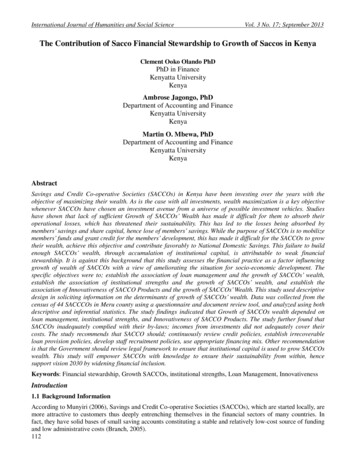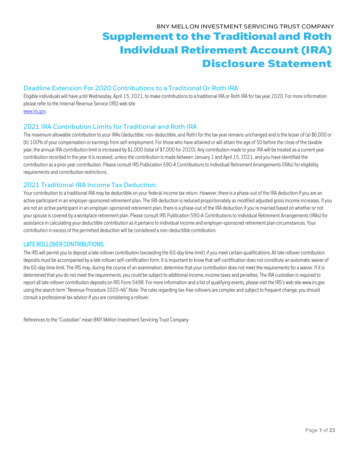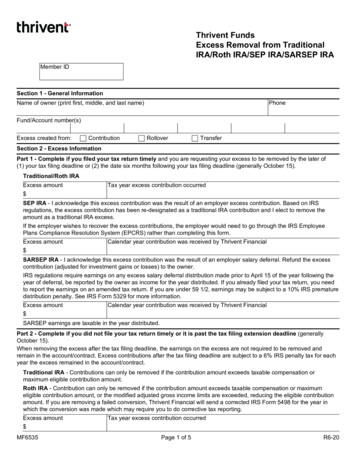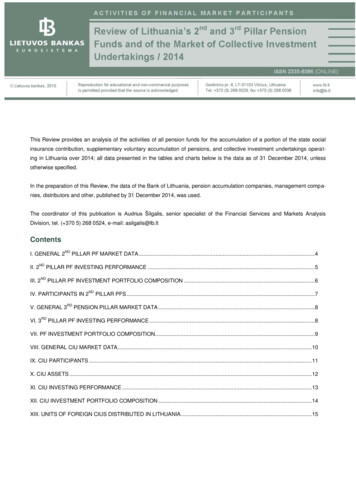
Transcription
International Journal of Humanities and Social ScienceVol. 3 No. 17; September 2013The Contribution of Sacco Financial Stewardship to Growth of Saccos in KenyaClement Ooko Olando PhDPhD in FinanceKenyatta UniversityKenyaAmbrose Jagongo, PhDDepartment of Accounting and FinanceKenyatta UniversityKenyaMartin O. Mbewa, PhDDepartment of Accounting and FinanceKenyatta UniversityKenyaAbstractSavings and Credit Co-operative Societies (SACCOs) in Kenya have been investing over the years with theobjective of maximizing their wealth. As is the case with all investments, wealth maximization is a key objectivewhenever SACCOs have chosen an investment avenue from a universe of possible investment vehicles. Studieshave shown that lack of sufficient Growth of SACCOs’ Wealth has made it difficult for them to absorb theiroperational losses, which has threatened their sustainability. This has led to the losses being absorbed bymembers’ savings and share capital, hence lose of members’ savings. While the purpose of SACCOs is to mobilizemembers’ funds and grant credit for the members’ development, this has made it difficult for the SACCOs to growtheir wealth, achieve this objective and contribute favorably to National Domestic Savings. This failure to buildenough SACCOs’ wealth, through accumulation of institutional capital, is attributable to weak financialstewardship. It is against this background that this study assesses the financial practice as a factor influencinggrowth of wealth of SACCOs with a view of ameliorating the situation for socio-economic development. Thespecific objectives were to; establish the association of loan management and the growth of SACCOs’ wealth,establish the association of institutional strengths and the growth of SACCOs’ wealth, and establish theassociation of Innovativeness of SACCO Products and the growth of SACCOs’ Wealth. This study used descriptivedesign in soliciting information on the determinants of growth of SACCOs’ wealth. Data was collected from thecensus of 44 SACCCOs in Meru county using a questionnaire and document review tool, and analyzed using bothdescriptive and inferential statistics. The study findings indicated that Growth of SACCOs wealth depended onloan management, institutional strengths, and Innovativeness of SACCO Products. The study further found thatSACCOs inadequately complied with their by-laws; incomes from investments did not adequately cover theircosts. The study recommends that SACCO should; continuously review credit policies, establish irrecoverableloan provision policies, develop staff recruitment policies, use appropriate financing mix. Other recommendationis that the Government should review legal framework to ensure that institutional capital is used to grow SACCOswealth. This study will empower SACCOs with knowledge to ensure their sustainability from within, hencesupport vision 2030 by widening financial inclusion.Keywords: Financial stewardship, Growth SACCOs, institutional strengths, Loan Management, InnovativenessIntroduction1.1 Background InformationAccording to Munyiri (2006), Savings and Credit Co-operative Societies (SACCOs), which are started locally, aremore attractive to customers thus deeply entrenching themselves in the financial sectors of many countries. Infact, they have solid bases of small saving accounts constituting a stable and relatively low-cost source of fundingand low administrative costs (Branch, 2005).112
Center for Promoting Ideas, USAwww.ijhssnet.comMore so, SACCOs are able to advance loans at interest rates lower than those charged by other financialproviders. In addition, SACCOs have the ability and opportunity to reach clients in areas that are unattractive tobanks such as rural or poor areas The core objective of SACCOs is to ensure members empowerment throughmobilization of savings and disbursement of credit (Ofei, 2001). SACCOs in Kenya in their struggle to achievethis objective have beem able to mobilized over Kshs.200 billion in savings (Co-operative Bank of Kenya, 2010).Savings mobilization should be backed by adequate institutional capital which ensures permanency, providecushion to absorb losses and impairment of members’ savings (Evans, 2001). The institutional capital whichcomprises the core capital and less share capital is mainly accumulated from appropriation of the surpluses.Therefore, SACCOs should strive to maximize on the earnings to build the institutional capital (Branch &Cifunentes, 2001; Ombado, 2010). This institutional capital ensures the permanence and growth of the SACCOseven in turbulent economic times (Evans, 2001). In fact, it helps the SACCOs to grow and, remain economicallyand financially viable (Gijselinckx & Devetere, 2007). Such growth is enhanced by effective financial practices.Imperatively, each SACCO needs to generate income which is adequate to cover all its operational costs, enhancethe institutional capital, dividends and rebates. In this regard, financial practice is based on sound financialstewardship, solid capital structure, and prudent funds allocation strategy (Maina, 2007). It is in this regard thatthere are financial management theories that explain the growth of wealth in terms of financial stewardship(governance) (Zetche, 2007; Annas, 2003; Abdullah &Valentine 2009; (Flannery &Hankins, 2007; DeMarzoy,Fishmanz, Hex & Wang, 2010). These theories have pointed to the lack of strong financial stewardship as leadingto stagnation of growth of wealth.Relevant theories on financial stewardship emphasize on value maximisation leading to growth of wealth. Thesetheories include; the stakeholder theory which emphasises on corporate decisions (Sundaram & Inkpen, 2004),virtue ethical theory which encourages stewards to conduct themselves appropriately (Zetsche. 2007), agencytheory which suggests that the stewards should make financial decisions for maximisation of shareholders value(Daily, et al., 2003; Clarke, 2004), stewardship theory that requires the stewards to ensure maximisation offinancial performance (Abdullah & Valentine 2009). Other theories include; transaction cost theory which stressesfor highly qualified stewards for maximisation of wealth (Abdullah & Valentine 2009), finance theory whichstates that the stewards must act in a manner to maximise shareholders’ wealth (Blair, 1995; Keasey, et al., 2004)taking into consideration agency costs (Jensen & Meckling, 1976), and myopic market model which states thatthe the stewards should make short term decisions to increase share value (Keasey,et al., 2004).Financial stewardship being the routine financial decision-making of the SACCO, should embrace sound businesspractices. This should also revolve around the SACCOs’ financial discipline with a profound influence on thesuccess of all businesses conducted by the SACCOs (Mudibo, 2005). The major financial decisions involved infinancial stewardship, for instance, include decisions on finance staff, loan management, asset management andproduct innovation (Horne, 2003, and Mudibo, 2005). The financial stewardship should be capable of working toincrease SACCOs’ wealth, sustain the SACCOs’ value and satisfy the shareholders’ demands. Further, thefinancial stewardship aspect is also responsible for updating accounts, ensuring correctness of accounts, advanceplanning and reporting to members.Further, The Vision 2030 strategy among other things requires the financial services sector to play a critical role inmobilizing the savings and investments for development of the country by providing better intermediate betweensavings and investments than at present. This sector will assist the mobilization of investment funds required toimplement the projects of Vision 2030. SACCOs are among the financial services strategies to be implemented inthis exercise. Service provided by savings and credit cooperative organizations (SACCOs) and other majorfinancial institutions will play a crucial role in improving the reach and access of financial services (currently only19% of Kenyans have access to formal financial services). It is notable that the financial services contribute about4 per cent to GDP and its assets contribute equivalent to about 40 per cent of GDP. In the vision 2030, there willbe development of vibrant and stable financial system to mobilize savings, and to allocate these resources moreefficiently in the economy, where the participation of SACCOs will be very crucial (Government of the Republicof Kenya, 2008). The sustenance of SACCO would widen the financial inclusion ‘net’ to include the excludedmajority (those regarded as poor in the society).113
International Journal of Humanities and Social ScienceVol. 3 No. 17; September 2013SACCOs in Africa are still crawling as they are newcomers, among those offering savings and credit. In fact theysmall share in providing financial services, their market share is insignificant when compare to other player infinancial service provision (Mwakajumilo, 2011). There are 28 countries in Africa that have established SACCOs(Savings Plus, 2010).1.2 Statement of the ProblemAs Mudibo (2005), posits, the objective of SACCO Societies is member empowerment through savingsmobilization, disbursement of credit and ensuring SACCOs’ long-term sustainability through prudent financialpractice. However, there are a number of challenges in promoting quality financial management such as limitedcapital funding sources, loan delinquency, and assessment and management of risks. Ademba (2010), postulatesthat SACCOs in Kenya are faced by such problems as; poor governance and, lack of members’ confidence,among others, while Ndung’u (2010), adds that the SACCOs are encompassed by mismanagement and poorinvestment decisions. Earlier, Thabo, et al., (2003) note that SACCO societies have problems generating wealthdue to poor financial stewardship, under-capitalization of co-operative enterprises, high cost of funds, anddelayed member payments. Munyiri (2006) says that such challenges would hinder the achievement of the saidobjectives and even lead to decline in growth of SACCOs’ wealth.Over time, SACCOs have been trying to address members’ demands by mobilizing funds and granting credit tomembers. However, they have not been able to grow their wealth sufficiently through accumulation of enoughinstitutional capital to finance non-withdrawable capital funded assets, provide cushion to absorb losses andimpairment of members’ savings. However, previous studies (Agrawal et al., 2002; Adeyemo & Bamire, 2005;Deji, 2005; Asher, 2007; Ogsi, 2001) have shown that lack of Growth of SACCOs’ Wealth has threatened theirsustainability such that they have not been able to absorb their operational losses. This has led to the losses beingabsorbed by members’ savings and share capital which leads to their impairment. According to FinancialStewardship theories (Zetsche. 2007) stagnation of growth of SACCOs’ wealth is attributable to FinancialStewardship. While the purpose of SACCOs as put by Branch (2005), Munyiri (2006) and Ofei (2005) is tomobilize members’ funds and grant credit for the members’ development, this stagnation has made it difficult forthe SACCOs to grow their wealth, achieve this objective and contribute favourably to National DomesticSavings. It is not clear the exact relationship between Growth of SACCOs Wealth and financial stewardship.1.3 Objectives of the Study1.3.1 General ObjectiveThe main objective of the study was to investigate the contrition of the financial stewardship on the growth ofSACCOs’ wealth with a view to improving their operations for the benefit of the members and the country.1.3.2 Specific Objectivesi.ii.iii.1.4i.ii.iii.To establish the association of loan management and the growth of SACCOs’ Wealth.To establish the association of institutional strengths and the growth of SACCOs, Wealth.To establish the association of Innovativeness of SACCO Products and the growth of SACCOs, WealthResearch HypothesesH0:There is no dependence between growth of Sacco’s wealth and loan management.Ha:There is dependence between growth of Sacco’s wealth and loan management.H0:There is no dependence between growth of SACCO’s wealth and institutional strengths.Ha:There is dependence between growth of SACCO’s wealth and institutional strengths.H0:There is no dependence between growth of SACCO’s wealth and Innovativeness of SACCOProducts.Ha:There is dependence between growth of SACCO’s wealth and Innovativeness of SACCOProducts.1.5 Significance of the StudyThe information acquired from this study will be useful to policy-makers both in the government and SACCOs,especially in strengthening policy considerations in this sector. Such policy improvement may be handy inenhancing the guidelines on how to improve the performance and effectiveness of SACCOs in an effort toenhance their efficiency for the benefit of the members.114
Center for Promoting Ideas, USAwww.ijhssnet.comInformation on the use of financial resources and their influence on the growth of SACCOs’ wealth will be usefulin ensuring prudent investment and efficiency in the management of the members’ wealth. This may also improveefficiency in financial practice of SACCOs’ wealth. This may lead to members’ satisfaction and trust in thesocieties and hence increased share contribution. As a consequence, SACCOs may be on the right track in theachievement of their goals as stipulated in their official and policy documents. The study may open opportunitiesfor further research in the area of co-operative movement in Kenya and especially in SACCOs. The study findingswill propose some proprietary financial practice to the SACCOs. It will be noted that especially the low-incomegroup will benefit from this knowledge without having to pay royalty fees. Finally, the study provides informationon the vision 2030 as regards SACCOs and the role of SACCO in ensuring achievement of this vision’sobjectives.1.6 Scope of the StudyThe study focused on the financial stewardship as a factor influencing growth of SACCOs’ wealth. It should benoted that in the SACCO Society movement, a distinction is made between shareholders and SACCOs’ wealth.Growth of shareholders’ wealth focuses on empowerment of members through accumulation of savings andprovision of credit at low interest while growth of SACCOs’ wealth focuses on accumulation of nonwithdrawable funds in the form of institutional capital and share capital. The aim of this study was to assess thedeterminants and establish how they influence the growth of SACCOs wealth. The study chose Meru Countyowing to its diversity in the type of SACCOs. This region has the three classification of SACCOs; rural, urbanand transport. Additionally, the region has SACCOs with large, medium and small membership. The studycollected data from all categories of SACCOs; rural, urban and transport for the period between 2005 and 2009.The SACCO societies are a sub-sector of the co-operative movement.Literature Review2.1 Theoretical Literature2.1.1 The Basis of Growth in SACCOs’ WealthThe Savings and Credit Co-operative Society (SACCOs) system encompasses a mutual membership organizationinvolving pooling voluntary savings together from cooperators in form of shares. SACCOs are user-ownedinstitutions with savings accumulated to act as SACCOs’ wealth. The shareholders share a common bond basedon a common area of interest or purpose, namely; their geographical area, employment, community or any otheraffiliation. The principal services of SACCOs include savings and credit but other services such as moneytransfers, payment services, insurance and member development are also offered (Maina, 2007). Indeed, in thewords of Branch (2005), SACCO societies are playing a very key role on savings mobilization for the benefit ofthe members.The prime concern of a SACCO Society is to build the financial strength that would ensure continued service tomembers. Apparently, the SACCOs’ wealth needs to be well-managed for the achievement of the SACCOs’objectives. In fact, the concern of this study was that the growth of SACCOs’ wealth is grounded on financialstewardship (decision-making aspect), capital structure and funds allocation strategy.2.1.2Financial Stewardship and Growth of SACCOs’ WealthFinancial stewardship is meant to increase and sustain SACCOs’ value and satisfy the needs and interests of allthe members. Accordingly, the financial manager is expected to provide information which will assist in decisionmaking concerning the investment of the SACCOs’ capital. The major financial decisions involved in corporategovernance include laying down basic objectives to be met, evaluation of the objectives, establishment of thebudget, budget approval, deciding on capital structure, cost of finance, fund raising, investment and distribution ofreturns (Horne, 2003 and Mudibo, 2005).In this context, the financial practice team needs to set up the objectives of the co-operative. They should come upwith alternative options to invest available funding and evaluate the core objectives by costing them. Thealternatives are ranked based on cost and benefit analysis and the best fit is selected. Once the team is satisfiedwith the selection, a budget is established for the selected objectives. This incorporates a plan to show how muchwould be incurred in carrying out the chosen alternative. The common budgets include working capital, revenue,cost of mobilizing funds, cash, and disbursement budgets.115
International Journal of Humanities and Social ScienceVol. 3 No. 17; September 2013These budgets are forwarded to the management committee for approval. The possible capital structure to investin the selected objectives is identified once the budget is approved. In this case, the management should identifythe required start-up capital and long-term finance in order to achieve its objectives. A decision is taken on themix with respect to optimum capital structure and considerations are made on the returns and risks of suchsources (Singh, 2003). The cost of capital for each different funding is evaluated because different types ofcapital carry different rates of return. For instance, loans without full security or with a high risk usually carryhigher rates of interest. The Return on Capital Employed (ROCE) is determined as well and expressed as apercentage of the capital employed in the co-operative business. The funds to be used in the investment are raisedfrom the sources identified during the mobilization of financial resources (Ross, 1998).After the required funds have been raised, they are then applied to generate income. This is the utilization of thefinance raised by the society in the selected objectives. This marks the implementation stage of the investmentidentified by the SACCO Society. However, after income has been obtained, the agent measures the results fromthe investment by preparing a statement of comprehensive income which shows the surplus, statement of financialposition indicating the financial state of affairs as at that time and cash flow statements. The managementcommittee determines whether the appropriate returns. The dividends and rebates are paid according to theSACCOs’ policy where the focus may be to distribute profits or set up reserves to pay debt in future or set sinkingfunds for retirement of debts (Pandey, 2010).The financial stewardship theories set the SACCOs’ objectives as value maximisation which is complemented bytheSACCOs’ vision. Key among these theories is the stakeholder theory which says that corporate decisionsshould consider the interest of shareholders (Sundaram & Inkpen, 2004). However, the theory is not a legitimatecontender of value maximisation (Jensen, 2001). Another theory, virtue ethical theory of corporate governancestates that SACCOs’ agents and shareholders should conduct themselves appropriately. The theory suggests anethical approach towards economic situations such as when there is less wealth or when there is competition(Zetsche. 2007). The theory involves effectiveness and intellectual aspects of the steward and virtues can beinstilled with education (Annas, 2003; Abdullah & Valentine 2009). This theory is very useful to this study in thatit will help to relate the staff ability to ability to growth of SACCOs’ wealth. Agency theory reduces the SACCOSociety to two participants; steward, and the shareholders (Daily et al., 2003; Clarke, 2004). According to thetheory, shareholders expect the stewards to act and make finanancial decisions in the interest of the shareholders(Padilla, 2002) with the aim of maximizing shareholders value. This theory provides a separation of ownershipand control (Bhimani, 2008).In the Stewardship Theory, stewards protect and make profits for the shareholders and they are satisfied andmotivated when SACCOs’objective is attained (Abdullah & Valentine 2009). It stresses that the executivemanagement are stewards who ensure they operate the SACCO Society to maximize financial performance aswell as shareholders’ profits (Daly et al., 2003). Donaldson & Davis (1991) contend that this theory appreciatesthe imporance of structure which empowers the agents and it allows for the stewards’s autonomy built on trust .This theory will assist in identfying the role of the finance staff in growing the SACCOs’ wealth. Transaction costtheory recognises that the organization and structure of a SACCO Society can determine its profitabality. Thistheory helps to establish the need for qualified staff in the SACCO Society for maximisation of the SACCOs’wealth (Abdullah & Valentine 2009).As with agency theory, the finance theory is concerned with ensuring that managers act to maximiseshareholders’ wealth. The theory is an efficient market model (Blair, 1995; Keasey et al., 2004) which acuallyrecognizes the agency costs (Jensen & Meckling, 1976). The myopic market model shares a common view withthe agency theory where the firm should serve shareholders’ interests only. According to the model, short-termperformance are encouraged thereby sacrificing long-term value and competitive capacity of the SACCO society(Moreland, 1995). According to the model, earnings can provide a clue as to the firms value (Stein, 1988). Thismodel argues out that maximization of shareholder wellfare does mean share price maximization. This is owing tothe fact that the market system tends to undervalue long-term expenditures which may lead to the increase of theshareholder welfare. Owing to myopic nature in the governance structure, the agents are forced to take short-termdecisions in increasing share prices (Keasey et al., 2004).2.2 Growth of Wealth TheoriesGrowth can be based on endogenous growth theory or neo-classical growth model.116
Center for Promoting Ideas, USAwww.ijhssnet.comThe neo-classical growth theory argues that the rate of growth is exogenously determined using the Harrod Damarmodel or Solow model. Solow-Swan class growth theory which focuses on capital and labour indicates thatcapital is added when SACCOs invest but is lost due to depreciation. The indication is that there is capital growthin wealth only when the investment exceeds depreciation (Gartner, 2006). The investment should insist onkeeping the capital growing to achieve capital growth. That increase in capital yields leads to an increase ingrowth of SACCOs’ Wealth. The theory explains growth as a factor of accumulation of capital. This model isstrongly supported by Harrod Damar Model of development economics (1946) which explains the growth rate interms of saving and productivity of capital. It explains that increase in investment leads to accumulation ofcapital.2.3Empirical LiteratureStudies have been carried out global, regional or local on growth of wealth explaining financial stewardship andan influencing factor. The present study considered the various studies identifying found beneficial. The studysought the relevant information on previous studies from university libraries, private libraries, and public libraryand through the internet search. Such material was in journals, research papers and working papers.In 1998, Mrema carried out a study on Tanzanian Women and Progress in Tuke Consumers' Marketing Cooperative. The study found that the SACCO Society had increased profits. It had also continued to pay dividendsto members. However, it faced challenges of illiteracy, lack of training, and business. It was recommended thatthrough economic power, members can meet their economic ends that act as motivation for other members to jointhe societies. The study by Mrema (1998) showed that there were increased surpluses but it failed to show howthe retained earnings increased as profits increased. There was also no clear definition of the economic powerneeded to grow the economic levels.In another study, Beck et al., (2000) examined the causal impact of financial development on growth and itssources where they found that there was a significantly positive causal impact of financial development on realper capita growth and productivity per capita growth. The study then recommended that positive repercussions forlong-run economic growth improve resource allocation and accelerate productivity growth. In the year 2001,Davies conducted a study to review the contemporary debate on governance within the co-operative sector andmake an analysis of the traditional approach taken by the movement. This study found that professionalmanagement was inevitably gaining ground against lay directors. The study then recommended that when peopleidentify with co-operative purpose and values, they would want to be involved. Good governance in co-operativeswas more a problem of management culture. Beck et al., (2000) study emphasized on growth of sources butlacked to indicate how these sources impact on the growth of wealth.A study by USAID (2001) found that co-operative autonomy was associated with success; governance structuresneed to be strong, transparent and honest; co-operatives needed to perform well to survive, endure and thrive; andsupport to co-operative development that creates dependency undermined the mutual self-reliance that is centralto cooperation. This led to their recommending that co-operatives needed to develop professional management inorder to adapt, innovate, and take rational risks to satisfy the expectations of their owners; and co-operativessucceeded when they consistently delivered value to their owners. The study by USAID (2001) very well showedthe need for good stewardship but it did not emphasize on how growth should be achieved. It only said that theyneeded to deliver effectively.Remezani et al., (2002) conducted a study associating corporate performance and SACCOs value creation togrowth in earnings and found that; EVA, ROE and ROI would rise earnings and sales growth; firms withmoderate growth in earnings showed highest rates of returns and value creation for their shareholders. In theirrecommendations, they said that; growth should not be the input to strategic planning but an outcome of soundinvestment strategy that is geared towards accepting value creating projects; and managers needed to shift theirstrategic goals from creating growth at the moment and waiting for surpluses later to enhancing profitable growthnow. The study findings by Remezani et al., (2002) were very much concerned with growth of wealth. It,however, only singled out the method of achieving this wealth (stewardship) but failed to include sources of fundsand funds allocation in the findings.Agrawal and Chadha (2005) and Agrawal and Cooper (2007) conducted another study to examine whether certaincorporate governance mechanisms were related to the probability of a firm restating its earnings.117
International Journal of Humanities and Social ScienceVol. 3 No. 17; September 2013In this study, they found that the key governance characteristics such as independence of boards and auditcommittees, and the provision of non-audit services by outside auditors were unrelated to the probability of acompany restating earnings. They recommended that independent directors with financial expertise were valuablein providing oversight of a firm’s financial reporting practices. The study by Agrawal and Chadha (2005) andAgrawal and Cooper (2007) related the growth of surpluses to the stewardship. It neither touched on the capitalstructure nor the allocation of funds.Other studies were carried in the year 2004 on growth of wealth. For example, Brown (2004) carried out a studyto measure corporate governance and firm performance. Brown then found that better-governed firms wererelatively more profitable, more valuable, and paid out more dividends to their shareholders. This study noted thatgood governance was associated with the firm performance. In another study, Det-Wet (2004) found that salesgrowth minus sustainable rate of growth did not contribute significantly to SACCOs’ value; there was significantcorrelation MVA and Estimated Value Added (EVA); and that there was a weak correlation between the MarketValue Added (MVA) and main drivers of (EVA). His recommendation was that managers needed to use thefinding to optimize their approach to SACCOs’ value management. Isabel (2004) carried out another study andfound that EVA performance was influenced by effective management (stewardship). Isabel then recommendedthat EVA was not very sensitive to the changing betas. The study by Bowen (2004) related the growth ofsurpluses to good stewardship. It, however, never associated this growth to other factors such as the capitalstructure or the allocation of funds. The findings were similar to those of Det Wet (2004) and Isabel (2004).Kaloi (2004) in another study found that there were delays in remittance; loan default; low monthly earnings andfailure to invest in illiquid investments led to losses hence no growth of wealth. The study recommended thatMinistry of Co-operative Dev
financial stewardship, for instance, include decisions on finance staff, loan management, asset management and product innovation (Horne, 2003, and Mudibo, 2005). The financial stewardship should be capable of working to increase SACCOs' wealth, sustain the SACCOs' value and satisfy the shareholders' demands. Further, the










